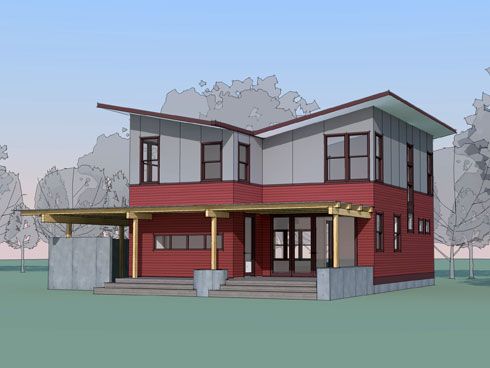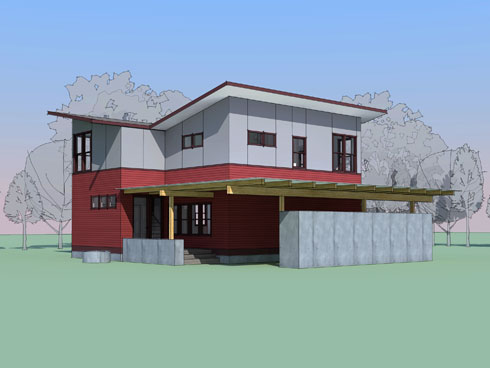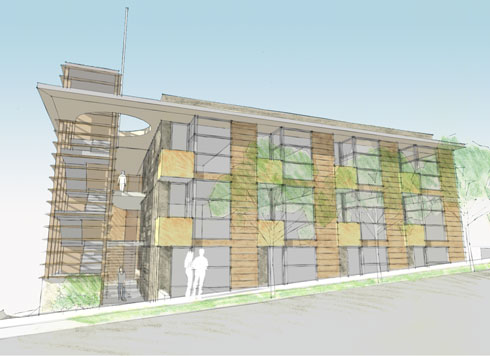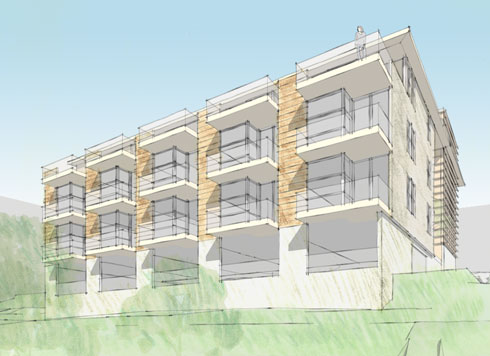
In December, Stefan and I asked Tim to become a full partner in CAST architecture. Tim has been with us since 2006, and has done some fantastic work, including the Artalejo-Lacas, Anderson and Bookloft residences.
Tim's work has been influenced by his interest in traditional Japanese architecture, small space design and Urban density issues. His path has been fueled by an 18-month research scholarship to study urban housing in Japan while a graduate student. This interest has most recently manifested itself in his efforts advocating for the passage of the Seattle Backyard Cottage ordinance. He is currently engaged in the design of efficient and elegant homes and cottages in various Seattle neighborhoods.
Tim is a registered architect in the State of Washington. He received a master of Architecture from the University of Washington and a Bachelor of Art and Design from Montana State University.
 This remodel and addition to a classic Tucker & Shield Mid Century Modern home in the Laurelhurst neighborhood of Seattle, strengthens the connection of rooms to one another, the public portions of the house to the site, and updates the finishes of this 1955 residence while staying true to the spirit of the original design.
This remodel and addition to a classic Tucker & Shield Mid Century Modern home in the Laurelhurst neighborhood of Seattle, strengthens the connection of rooms to one another, the public portions of the house to the site, and updates the finishes of this 1955 residence while staying true to the spirit of the original design.
A new day lit stair well creates a logical circulation path between the bedroom wing of the split-level, and the public spaces of the house, creating a more fluid transition to the second floor living. The new family room addition builds off the home’s original elemental language of brick, wood and glass, providing a deck to take in the expansive views of Lake Washington - Leveraging the house's connection to a quintessential Seattle site.
A special thanks to the project manager Rich Denny of High Country Contractors for being a great partner on this project!






- Saratoga Modern--exterior from backyard
Set in the Saratoga, California suburbs, this house is a complete reboot of a 1969 faux colonial. Â We're stripping away the historical pastiche, and focusing the design on nearly seamless indoor/outdoor living. Â Wrapping the house is a stone terrace and arcade which defines a new dining space, lounge area and a series of gardens. Â It screens the intense solar exposure, and reinforces the horizontal in keeping with the City's very restrictive planning regulations.

The palette of natural materials is pretty rich, but understated, using changes in texture and shadow. Â We'll be using a light colored, hard limestone, called Fiore from Maidenstone. Â We'll use a split face texture for the arcade columns, hammered tile for the outdoor terrace, and a brushed finish for the interior tile. Â The cabinetry and trim will be mostly walnut slab and panels.

More information and photos after the jump...



We've been investigating what the Urban Olympic project would look like as an 27 unit apartment building. Â One potentially excited twist on the building is that we have split the bulk into two volumes with a 18' wide courtyard atrium. Â The atrium and circulation are exterior, so we can apply another 2000 S.F.for an extra 3 units and still come in under the FAR limit.
We also did a first run at some energy modeling, using Archicad's EcoDesigner program, and feel that given the bulk it would be fairly straight forward to achieve the Passive House standard, but the return on investment is better if we design to the envelop to Washington State Energy Code, add solar hot water, switch the lighting to LEDs, and add an ERV.
Dave Boone has broke ground on our latest commercial project, The Canal Street Studio. This mixed use building on an infill lot in the Fremont neighborhood of Seattle, will house retail and office space, an artist's studio, and a caretakers residence. This live work studio for an interior designer/ceramicist and a writer, over looks the Fremont Canal, and is projected to be finished in spring of 2012.


Join us tonight at Future Shack 2011 for another evening of great dialogue about houses. Â Last year I participated in the 'Speed-Date'---seven minutes to lay out the project and have a design brainstorm, then on to the next architect. Â It was a blast, and this year Tim will be sitting in for me. After Speed Date Design, there will be a presentation of innovative ideas in housing.
Our entry, Urban Olympic, is a nine unit townhouse complex designed to use 90% less energy that typical code compliance housing. Â See our entries over the last few years : 2011, 2009
It is at Fisher Pavillion in the Seattle Center, starting at 5 pm.


A short subdivison in West Seattle is serving as the site for two prefabricated homes for a Seattle developer.
CAST worked with a modular factory in Oregon to understand the constraints involved with building, shipping, and installing factory built structures. Leveraging this knowledge we have designed a prototype house which balances the economy of modular construction with selective site built elements to gain the modulation, character, and function which stock prefabricated construction typically lacks.
By making changes to the homes orientation, location of site built portions of the structure such as awnings, eaves, parking, and decks, an extremely economical structure is tailored into a series of custom homes.
This new home was permitted under Seattle's citywide backyard cottage ordinance (which is rapidly approaching it's second year anniversary). The existing home, with a large corner lot and alley access, was an ideal candidate for a backyard cottage. The site allowed both the existing home and new cottage to enter from separate streets, have separate outdoor living areas and maintain a great deal of privacy from one another.
The owner desired a modestly scaled 800 square foot structure with exterior massing that followed the traditional lines of the existing home and a modern, light filled interior that opened to a private courtyard and was suitable for entertaining guests. The floor plan centers on a double height dining room with clerestory windows, sleeping loft and a large 4 panel door that frames views of the private courtyard and terraced garden. The cottage features radiant floor heating, an efficient on boiler with integrated solar hot water collection and a 1500 gallon cistern for rainwater catchment.
View from the dining room into the kitchen.
1,500 gallon cistern for rainwater catchment.
View from the kitchen into the dining room and living room.
Last night, we had about 50 people come out for drinks and a short program on pro bono design services. Â Two non profits were kind enough to speak a little about their experience with pro bono service and what it allowed them to accomplish (a lot!). Â One architect, Brian Palidar of GroupArchitect spoke about his partnership with the Sibling House Foundation, doing housing assessments/remodels to keep foster kids together. Â We ended with a Q&A covering a wide range of topics, from convincing management to prioritize pro bono services, to selecting non profit clients. I was very pleased with both the attendance and the response!
If you have questions about pro bono service, how to sign up, or would like to have me come to your non-profit and answer questions about how to capitalize on the amazing expertise of local design professionals, please contact me at matt@castarchitecture.com.







